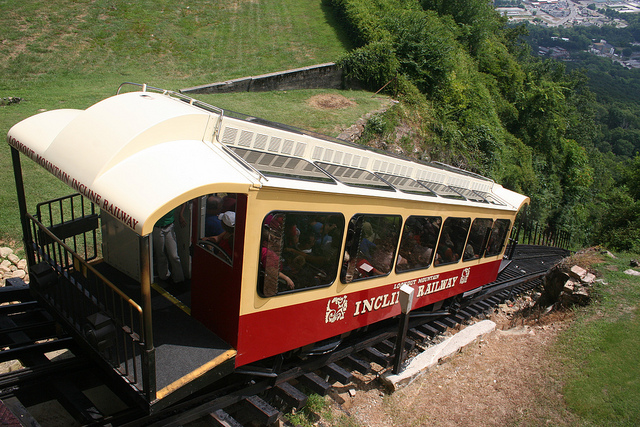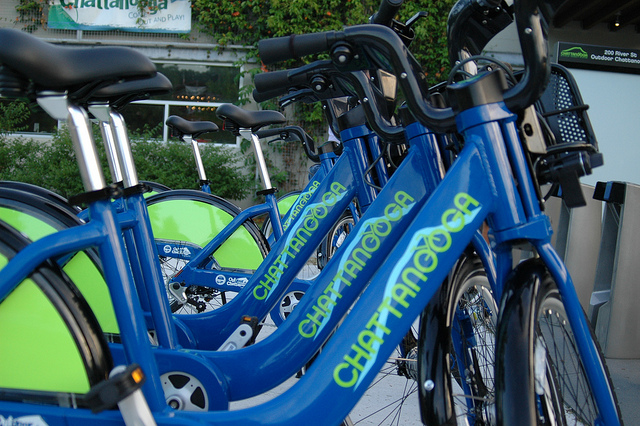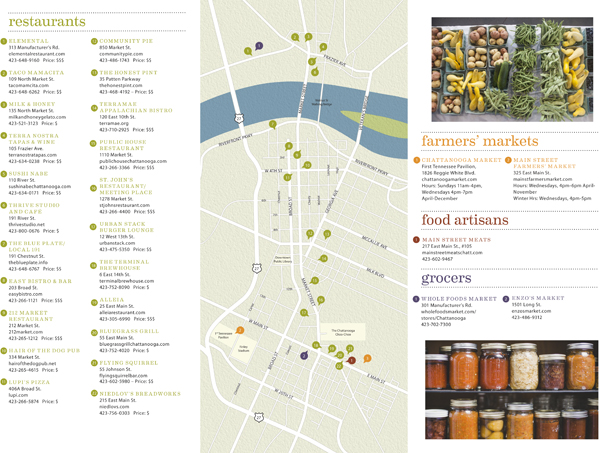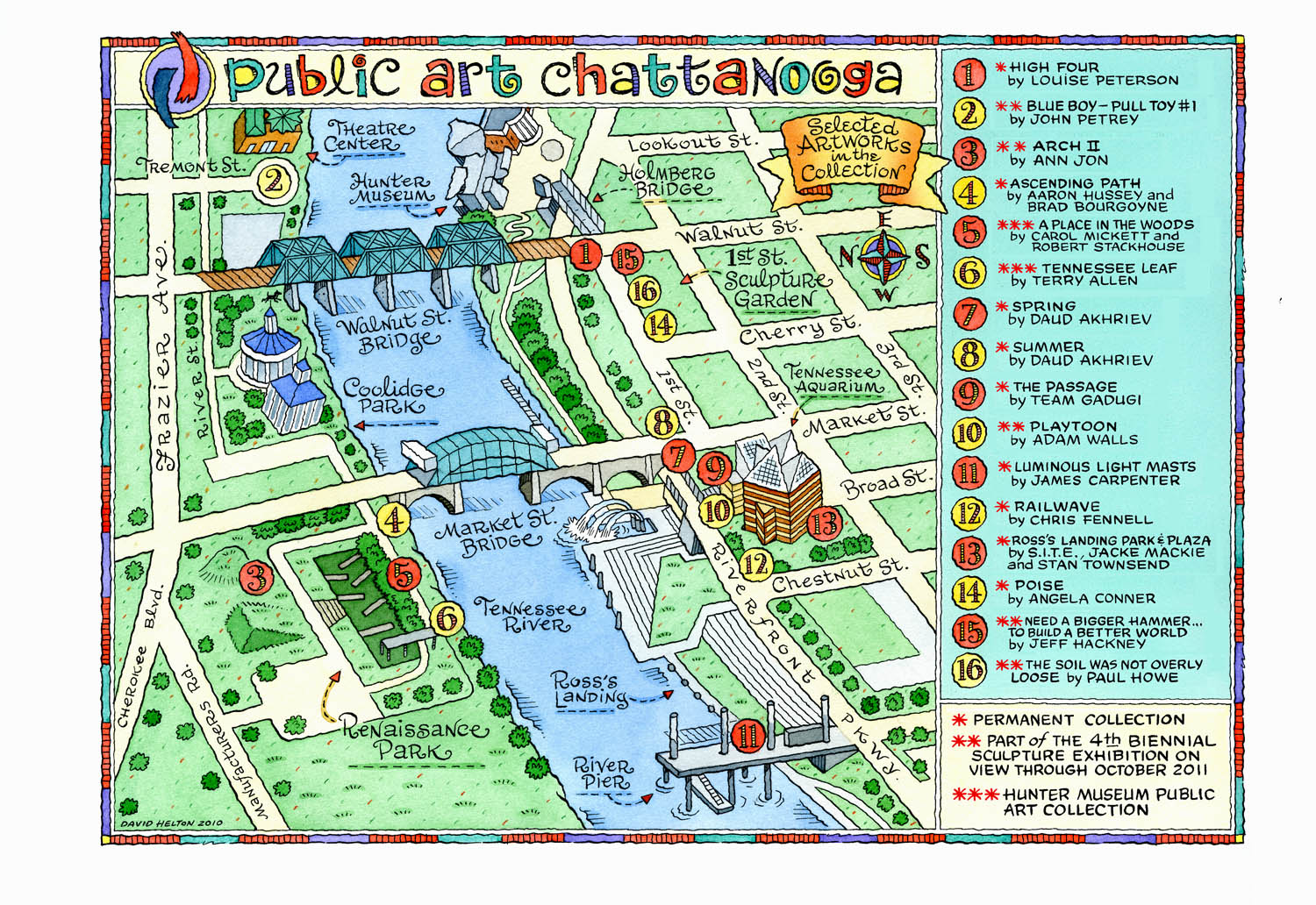Chattanooga skyline. Top photo credit: C Simmons / Foter / CC BY-NC 2.0.
Tucked down into the southeast corner of Tennessee, Chattanooga is, perhaps, the most unassuming city in the Volunteer State. Though it doesn't have the musical legacies of Nashville or Memphis, or the University of Tennessee like Knoxville, what Chattanooga's 170,000 residents do share is the fastest Internet speeds in the United States. That's right: Chattanooga is the first Western Hemisphere city running a one-gigabit-per-second fiber Internet service. It's 200 times faster than the national average and has earned Chattanooga its nickname, Gig City, along with a seat at the grown-up table.
The fact that Chattanooga is leading the way in infrastructure is not surprising to anyone who knows the place. Chattanooga also boasts the world's longest pedestrian bridge (Walnut Street Bridge), the world's largest freshwater aquarium (Tennessee Aquarium), the world's steepest passenger railway (Lookout Mountain Incline Railway), and the world's highest overland bungee cord jump (Chattanooga Adventure Sports). It was also once listed as the “dirtiest city in America” due to outrageous pollution, but have made so much progress environmentally that Outside magazine readers named it “best town ever”. And, the MoonPie originated at the Chattanooga Bakery in 1917.
Here are Chattanooga's top 11 Shareable innovations:
1. Public Utilities
EPB SmarterGrid HD from EPB Fiber Optics on Vimeo.
The aforementioned one-gig fiber optic network is not only fast, it's also publicly owned by Chattanooga's EPB utility company, and it supports their SmarterGrid system, which is the most advanced power grid in the U.S. As old infrastructure falters and decays around the country, even mild storms can cause power outages. Chattanooga's SmarterGrid avoids all that and preserves the $100 million a year revenue that the city would lose from down time. Not only does the network lead to more power reliability and energy conservation, but it also allows for increased productivity and broader innovation. Further still, a smart grid brings renewable energy options one step closer.
Danna Bailey, who handles corporate communications for EPB, explains, “We believe that Internet is becoming as critical today as electric power was at the beginning of the 20th century, and what we’ve done with the network we’ve built is lay a foundation for our community to have what it needs in terms of bandwidth for the foreseeable future. Much like the ubiquitous availability of electric power was a key factor in opening the door for innovation in the 1900s, we believe high-speed Internet will have a similar effect here. Because we chose to build a complete fiber optic network, our customers are only limited by the electronics on either end. As more applications are built, people will want more bandwidth — and the network we have is suited perfectly for that. … I think it’s infused a new sense of the possible. There’s a new level of confidence and excitement about our opportunity to engineer our own future in Chattanooga.”
2. Public Transit

Lookout Mountain Incline Railway. Photo credit: Chris Totsky / Foter / CC BY-NC-SA 2.0.
Cruising from public utilities over to public transit, Chattanooga's CARTA (Chattanooga Area Regional Transit Authority) runs the Lookout Mountain Incline Railway, as well as one of the nation's largest fleets of electric vehicles all of which have WiFi. Transporting a million passengers a year via electric vehicles keeps more than 65 tons of emissions out of Chattanooga's air. Although their once county-wide services were scaled back due to budget constraints, CARTA continues to innovate within those constraints having implemented one of the top Intelligent Transportation Systems (ITS) in the country back in 2008. Using GPS and computer-assisted dispatching technology, CARTA's Bus Tracker app provides real-time arrival information at bus stops along its routes. They also experiment with things like solar panels, gas turbines, alternative battery chemistries, inductive charging, and hydrogen auxiliary power units.
CARTA's communications manager, Veronica Peebles, notes, “CARTA has a reputation for innovation and excellence. The future of public transit in Chattanooga is exciting as we are constantly planning and discussing how we can be the regional transit provider that we once were. Our ongoing planning process includes, but is not limited to, evaluating our existing routes and services for potential expansion, studying traffic patterns, identifying the areas of economic development and growth, and seizing opportunities to partner with local government, other community businesses, and organizations who share our sentiment that an investment needs to be made in the future of public transportation in our region.”
3. Biking

Bike Chattanooga. Photo credit: Elly Blue / Foter / CC BY-NC-ND 2.0.
CARTA's buses aren't the only way to get around Gig City. Even though it's a somewhat sprawling town, Chattanooga is committed to getting its bike on. Starting in 2007, the city began surveying residents to gauge their interest in a bikeshare program. After 75 percent of the participants expressed a favorable regard for the idea, the Lyndhurst Foundation ponied up $100,000 and the city, in conjunction with CARTA, was able to secure additional federal air-quality funding to get Bike Chattanooga on its feet… or wheels, as the case may be. Some 12,600 riders took spins in the program's first six months. A few years later, Bike Chattanooga has 300 bikes at 33 stations across the city and ridership is way up.
Ben Taylor of Chattanooga's Transportation Department: “The Chattanooga Bicycle Transit System is a key piece of the city transportation department’s commitment to supporting all modes of transportation. Bike Chattanooga just had its second anniversary with over 78,000 trips taken. That’s an over 40 percent increase in trips in our second year. Several protected bike lane projects are in the works, so we will see cycling increase as we make our street accessible to a wider range of the public.”
4. Local Food

The TasteBuds local food map. Photo credit: Crabtree Farms.
Like up-and-coming cities everywhere, Chattanooga is hopping on the local food bandwagon with farmers' markets, community gardens, and CSAs like Chattanooga Market, River Market, Main Street Market, Fair Share Urban Growers, Colvin Family Farm, and Signal Mountain Farm, along with a slew of restaurants that source their ingredients from area farmers. As, perhaps, the leader of the pack, Crabtree Farms worked in collaboration with the Benwood Foundation's Gaining Ground program to create TasteBuds, a guide and map that helps folks identify all of those eateries, shops, and other programs that focus on local food.
Andrea Jaeger, Programs Coordinator at Crabtree Farms, enthuses, “We’re at an exciting point right now when fresh, local foods are becoming more available to all of Chattanooga, which could have a tremendously positive impact on our local economy. With an increase in local farmers' markets, restaurants, and grocers sourcing from farmers; an increasing number of community supported agriculture (CSA) programs; and resources including the TasteBuds local food guide, local people are able to connect directly to the farmers who grow their food. What’s more, nearly half of our local farmers' markets accept Supplemental Nutrition Assistance Program (SNAP) benefits, and a new ordinance allows for SNAP to be used to purchase CSA shares, making local food an option for all income levels. When we buy local, we have more control over our food choices, enabling us to enjoy fresher, more delicious foods. Not only that, we can keep our food dollars closer to home. A study in 2008 found that if every Chattanoogan were to spend just 5 percent of their total food budgets on local food, we’d add an impressive $100 million to our local economy. We are hoping that, with the way things are going now, we can even double that!”
5. Sustainable Building

A LEED certification on Main Street. Photo credit: Larry Miller / Foter / CC BY-NC 2.0.
Chattanooga's push toward sustainability doesn't stop at its smart grid, bikesharing, and local food. For the past six years, Gig City has been going green wherever and whenever it can. That means the new Volkswagen plant, the EPB facility, Riverview Animal Hospital, Cohutta Bank, Firestation Nos. 4 and 7, Majestic 12 Cinema, Hampton Inn and Suites, and 23 others are all LEED-certified buildings with 24 more in awaiting approval. Not only that, but the Chattanooga Airport’s new corporate flight center is the first terminal in the world to garner a LEED Platinum certification. In fact, solar arrays are currently being installed and will eventually power the whole airport.
green|spaces has been very involved with the greening of Gig City, as Michael Walton, the group's new Executive Director, noted: “The future of sustainability and green building in Chattanooga is strong. Those businesses, institutions, and individuals that care about the occupants of their buildings and their bottom line, and who are leaders in the community, will continue to pursue LEED certification. Those who don't qualify for or can't afford to pursue LEED certification can turn to our new green|light program for Chattanooga's local green businesses. We are building a series of next-generation houses which will go above and beyond LEED and look toward the Living Building Challenge, the ultimate green building standard. We also continue to educate local developers, design professionals, builders, and the general public about the latest best practices to help raise the standard of building. Finally, we are working on developing a plan to dramatically improve energy efficiency and affordability of utilities in low-income neighborhoods to help families afford better food, housing, and healthcare.”
6. Housing
Building our Future from The Crash Pad:An Uncommon Hostel on Vimeo.
Speaking of sustainable housing, Chattanooga really is putting its money where its mouths are. There's the Seniors Together co-housing project, the Fairmount Avenue affordable (and LEED-certified) townhouses, the Madison Street modern (and LEED-certified) homes, and the various affordable housing complexes under the Chattanooga Housing Authority's purview including Maple Hills and Edward F. Steiner apartments. Even people looking for sustainable short-term housing options need to look no further than The Crash Pad hostel.
John Ying, the Crash Pad's General Manager, says, “The Crash Pad was created three years ago to fill an empty niche in the Chattanooga community for sustainably built, shared overnight stays. The hostel model invites sharing, creativity, and respect for those outside of your norm. Family dinners, lawn games, and ride shares are beautiful and frequent occurrences when one regards strangers as potential friends. One of our missions is to reeducate tourists about a different way to travel rather than locking the hotel room door and turning on the TV. Creating a shared space where our guests can ask others what they did today or sights they've seen ensures an experience that's tailored to them and their interests. We want the Crash Pad to act as an inspiration to commercial and residential developers to go green from the beginning and upgrade with sustainable techniques. We are eager to share our knowledge and do often! Chattanooga is perfectly set up to build more sustainably, and, given our history, it's really a no brainer. We don't want to go back to our past; being declared the dirtiest city in America once was once too many.”
7. Community Development

A Glass House Collective public art project. Photo credit: Glass House Collective.
Sustainable buildings and homes are great, but populating them with community-minded residents is even better. In Chattanooga, a few different collectives have come together to bring together those sorts of groups. The Movement Arts Collective offers, well, movement arts such as yoga and dance to area residents. The NorthShore Merchants Collective brings together merchants and business owners on the NorthShore to help preserve and promote their neighborhood. They also issue NorthShore Bucks, a sort of local currency that most of the merchants accept. The Glass House Collective is all about creative placemaking. They get people out on the streets and into the neighborhood through various programs, as well as grants to artists who spend a year working on neighborhood art projects in Glass Street studios.
Glass House Collective's communications and outreach director Teal Thibaud “Chattanooga is known for working with public and private partners to invest in places others have overlooked. For example, the Aquarium, Miller Plaza, Riverfront, and Main Street — those specific places have continued to have a positive ripple effect on their surrounding communities. Moving forward, as investment and partners pool together to continue making our city center more vibrant the efforts to rebuild forgotten neighbors is key to sustain the redevelopment efforts in downtown proper.”
8. Shared Spaces

Members collaborating at Society of Work. Photo credit: Society of Work.
With all that Internet speed, all sorts of projects and professionals are bound to be needing space. That's why Gig City offers a variety of work spaces, sized — and styled — to fit. While the Chattanooga WorkSpace might sound like a coworking hotspot, it's actually geared toward artists, but it also has room for events. Over at the multi-purpose Camp House, there's a coffee house, a mobile office, an event space, and, until recently, a thrift store. For straight-up office and coworking space, the Concierge Office Suites and the Society of Work are the places to be, along with two shared maker spaces — Chattlabs and the 4th Floor at the Chattanooga Public Library — and the Artifact crafter's cooperative.
Society of Work's founder Kelly Fitzgerald notes, “Coworking in Chattanooga has had an organic growth cycle. As a true business model, coworking didn't exist until Society of Work (SOW). However, there were VC firms and business incubators started in 2011, and earlier in some cases. These organizations still exist, but unless you are you are being incubated by these entities, you can't work there and share amenities with other small businesses. Without these initial businesses, I don't think SOW would have gained traction as quickly as it has. Chattanooga has been a tricky market in that a large number of people think of shared office space as four walls within another four walls. Coworking succeeds when people have the ability to make their own space; hence, why all of our furniture is on wheels — it is truly their office. Coworking is the conduit, providing shared amenities and resources that can help build business. The open office aspect is, in some ways, no different than working in a large corporate setting. Through coworking, people have an opportunity to pave their own path and create an independence that a corporate job often does not provide. For the right person, it is the perfect environment to thrive. Chattanooga is highly supportive of small business and, for that reason, I see coworking as something that will continue to grow, even if we have started a little bit behind the curve.”
9. Business

The Idea Board at GigTank. Photo credit: Larry Miller / Foter / CC BY-NC 2.0.
Speaking of small businesses, Chattanooga was, a century ago, the entrepreneurial hub of the South, situated comfortably on the Tennessee River between Atlanta, Birmingham, Nashville, and Knoxville. Add the low cost of living to the SmarterGrid and a growth spurt is inevitable. Choose Chattanooga works hard to attract innovators, then the Chattanooga Renaissance Fund helps out with angel investments. One of the other main players in the business is The Company Lab which runs its CO.LAB Accelerator mentorship program for entrepreneurs as well as GigTank, a 14-week accelerator program focused on utilizing Chattanooga's fiber optic network.
Mike Bradshaw, CO.LAB's Executive Director, believes, “We’ve reached a new moment of opportunity for entrepreneurs in Chattanooga. Over the last few years, a number of critical startup resources have sprung up and aligned forces with existing business development entities in our area. Thanks to the responsiveness of our angel capital community and coordination among local startup supporters, Chattanooga’s entrepreneurial ecosystem now supports new companies at every level of the growth process, from business ideation to capital recruitment to longer-term incubation. As more people take advantage of these resources, we expect entrepreneurial activity in our area to continue to grow and create new economic opportunity for those who live here.”
10. The Arts

PAC's Art Trail map. Photo credit: Public Art Chattanooga.
Chattanooga is so invested in the arts that they have a Public Art Chattanooga (PAC) commission through which they desginate grants for public art projects. There's also 4 Bridges Arts Festival put on by the Association for Visual Arts as a way to connect art and community and the ArtsBuild fund and council, which is focused on supporting a healthy, multi-cultural arts environment in Hamilton County. And when those newly funded artists need a place to perfect their crafts, the Chattanooga WorkSpace provides studio, gallery, and event space to artists.
Chris Thomas, Executive Director of the Chattanooga Market which houses Chattanooga WorkSpace, “We see a lot of fresh momentum in Chattanooga regarding the arts, including a new influx of artists moving to our city because of all the opportunities and infrastructure emerging. At our own facility, we've seen tremendous interest for professional studio space and have maintained nearly 100 percent capacity since opening. There is also a lot of energy surrounding the creative live/work concepts several organizations in town are pursuing — all of which strengthens our art scene.”
11. Repurposed Goods

A true Tennessee-style belt buckle. Photo credit: Collective Clothing.
Across the board, it seems that reducing, reusing, and recycling is the name of the game in Chattanooga, and that applies to various goods. Three major flea markets — East Ridge Flea Market, I-75 Flea Market, and Sweetwater Flea Market — afford bountiful opportunities to find perfectly good stuff. Meanwhile, Green Door Trading Co. and Collective Clothing both offer more fashionable selections, and McKay Used Books covers various media. The Community Kitchen also has two wonderful repurposing programs that support Gig City's homeless community. Pedal Power restores bikes and gives them to homeless people as a means of empowerment and a mode of transportation, and Consider the Lilies Thrift Store and Give-away Program provides clothing to the same population, as well as revenues for the Kitchen.
Sondra Aten, Co-owner of Collective Clothing, feels, “Recycling has always been in fashion. Some people are more involved than others, but anyone could benefit from adding a second-hand clothing item to their wardrobe. Chattanooga is really supportive of our two stores, which sell second-hand modern and vintage clothing and accessories. But a lot of people still come in and wonder what we are and exactly what we are selling. For those people, I have some advice: You may find it easy to start buying vintage by adding a staple such as jeans or cut-offs to open yourself up to the idea of wearing vintage. My challenge is to find the person that isn't sure, and help them find the look they like and feel comfortable in. I'm always amazed when you meet someone that used to only dress in new apparel, and then a month later is rocking a flashy statement piece from a thrift shop. Converts are the reason we thrive. Second-hand fashion can be inspired by a variety of things and we try to stay informed of what people are buying and are constantly changing what we have to offer based on that. But, all together, Chattanooga is an upcoming city when it comes to second-hand fashion and we are proud to be a part of it!”









